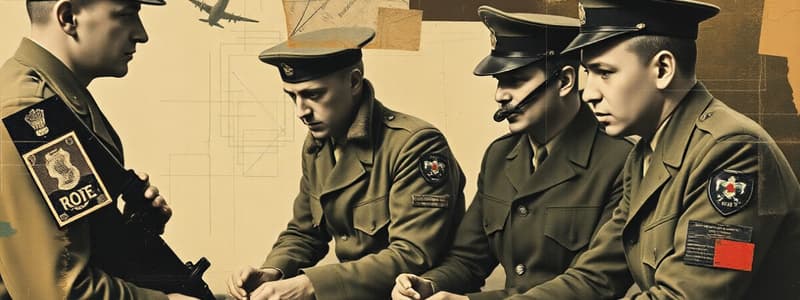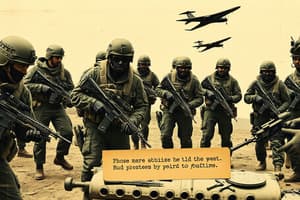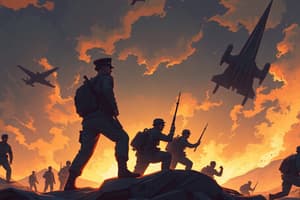Podcast
Questions and Answers
Which of the following is a challenge to building and maintaining a team in a command headquarters?
Which of the following is a challenge to building and maintaining a team in a command headquarters?
- Limited communication and coordination among staff sections.
- Frequent changes and augmentations in personnel within the headquarters. (correct)
- Lack of clearly defined functional responsibilities in the headquarters.
- Insufficiency of equipment for staff sections.
What is the primary role of the Commander in fostering staff teamwork?
What is the primary role of the Commander in fostering staff teamwork?
- Directing the intelligence staff's participation in planning methodologies.
- Analyzing intelligence data and developing actionable insights.
- Supervising the intelligence staff's participation in intelligence tasks.
- Ensuring staff sections have sufficient resources to perform their duties. (correct)
How does the intelligence staff contribute to overall staff teamwork?
How does the intelligence staff contribute to overall staff teamwork?
- By providing tactical guidance to the commander during operations.
- By incorporating their perspectives and knowledge into broader staff operations. (correct)
- By focusing solely on intelligence tasks and avoiding other staff functions.
- By directing other staff sections in their operations.
What is the main value of staff participation in intelligence tasks like IPOE and collection management?
What is the main value of staff participation in intelligence tasks like IPOE and collection management?
Besides IPOE and collection management, in which intelligence tasks does staff participation have a lesser but still significant value?
Besides IPOE and collection management, in which intelligence tasks does staff participation have a lesser but still significant value?
What is the primary reason for the need of staff participation in intelligence tasks?
What is the primary reason for the need of staff participation in intelligence tasks?
Which of the following is an example of support provided by other staff sections to the intelligence staff?
Which of the following is an example of support provided by other staff sections to the intelligence staff?
What is the key takeaway about the relationship between the commander, staff, and intelligence functions?
What is the key takeaway about the relationship between the commander, staff, and intelligence functions?
What is one of the main responsibilities of an information operations officer?
What is one of the main responsibilities of an information operations officer?
Which of the following tasks is NOT associated with the military deception officer?
Which of the following tasks is NOT associated with the military deception officer?
What does the operations security officer specifically provide?
What does the operations security officer specifically provide?
What is a primary role of the information operations officer regarding threats?
What is a primary role of the information operations officer regarding threats?
Which aspect is considered by the military deception officer when coordinating operations?
Which aspect is considered by the military deception officer when coordinating operations?
What type of overlays does the information operations officer develop?
What type of overlays does the information operations officer develop?
Which element is NOT included in the responsibilities of the military deception officer?
Which element is NOT included in the responsibilities of the military deception officer?
What is a responsibility of the collection management team?
What is a responsibility of the collection management team?
Which of the following is NOT a primary responsibility of the staff, as outlined in the text?
Which of the following is NOT a primary responsibility of the staff, as outlined in the text?
Which of the following is NOT a way the staff supports the commander in understanding the operational environment?
Which of the following is NOT a way the staff supports the commander in understanding the operational environment?
In terms of staff responsibilities, what does the acronym "PED" represent?
In terms of staff responsibilities, what does the acronym "PED" represent?
When does the staff need to make adjustments to the plan or tasks in the operational environment?
When does the staff need to make adjustments to the plan or tasks in the operational environment?
What is the role of the G-2/S-2 staff officer in relation to the intelligence warfighting function?
What is the role of the G-2/S-2 staff officer in relation to the intelligence warfighting function?
Which staff officer is responsible for civil affairs?
Which staff officer is responsible for civil affairs?
What is the significance of the phrase "battle tracking" in the context of the text?
What is the significance of the phrase "battle tracking" in the context of the text?
What is the most important function of knowledge management in the text?
What is the most important function of knowledge management in the text?
What does the acronym CCIR stand for?
What does the acronym CCIR stand for?
Which of the following roles does G-3/S-3 signify?
Which of the following roles does G-3/S-3 signify?
What is the purpose of an OPORD?
What is the purpose of an OPORD?
Which element is NOT part of the key integrating processes?
Which element is NOT part of the key integrating processes?
What does MCOO stand for?
What does MCOO stand for?
What does HVT represent in military terminology?
What does HVT represent in military terminology?
What does the term PIR refer to?
What does the term PIR refer to?
What is indicated by the acronym LTIOV?
What is indicated by the acronym LTIOV?
What is required from the rest of the staff in relation to key intelligence processes?
What is required from the rest of the staff in relation to key intelligence processes?
Which activity is NOT mentioned as requiring the participation of the entire staff?
Which activity is NOT mentioned as requiring the participation of the entire staff?
What is a primary benefit of the entire staff participating in intelligence processes?
What is a primary benefit of the entire staff participating in intelligence processes?
How does participation from the entire staff support the commander?
How does participation from the entire staff support the commander?
What is highlighted as a key aspect of teamwork within a staff?
What is highlighted as a key aspect of teamwork within a staff?
What does the intelligence staff lack according to the content?
What does the intelligence staff lack according to the content?
What does synchronizing combat power within an operation achieve?
What does synchronizing combat power within an operation achieve?
Why is it important for all staff members to be familiar with other staff sections' duties?
Why is it important for all staff members to be familiar with other staff sections' duties?
What is the primary role of the enemy situation template in COA analysis?
What is the primary role of the enemy situation template in COA analysis?
Which action should be taken as part of identifying new information requirements?
Which action should be taken as part of identifying new information requirements?
How should the results of enemy actions and counteractions be recorded during the COA analysis?
How should the results of enemy actions and counteractions be recorded during the COA analysis?
What is one of the responsibilities of the command’s senior intelligence officer during COA analysis?
What is one of the responsibilities of the command’s senior intelligence officer during COA analysis?
What is the purpose of refining the situation and event templates during the COA analysis?
What is the purpose of refining the situation and event templates during the COA analysis?
During COA analysis, participating in the targeting process includes which of the following?
During COA analysis, participating in the targeting process includes which of the following?
Which factor must be considered when analyzing the effects of enemy and friendly COAs?
Which factor must be considered when analyzing the effects of enemy and friendly COAs?
Which of the following is a suggested method to project enemy losses?
Which of the following is a suggested method to project enemy losses?
Flashcards
CEMA
CEMA
Cyberspace Electromagnetic Activities, operations in cyberspace and electromagnetic spectrum.
IPOE
IPOE
Intelligence Preparation of the Operational Environment, assessing factors impacting operations.
G-2/S-2
G-2/S-2
Division or corps/battalion or brigade intelligence staff officer overseeing intelligence activities.
Support Commanders
Support Commanders
Signup and view all the flashcards
Battle Tracking
Battle Tracking
Signup and view all the flashcards
Decision Criteria
Decision Criteria
Signup and view all the flashcards
OE
OE
Signup and view all the flashcards
Intelligence Warfighting Function
Intelligence Warfighting Function
Signup and view all the flashcards
Staff Participation
Staff Participation
Signup and view all the flashcards
Operational Environment (OE)
Operational Environment (OE)
Signup and view all the flashcards
Key Intelligence Processes
Key Intelligence Processes
Signup and view all the flashcards
Mission Analysis
Mission Analysis
Signup and view all the flashcards
Collection Management
Collection Management
Signup and view all the flashcards
Synchronization of Combat Power
Synchronization of Combat Power
Signup and view all the flashcards
Staff Cooperation
Staff Cooperation
Signup and view all the flashcards
Staff Coordination
Staff Coordination
Signup and view all the flashcards
Battle Rhythm
Battle Rhythm
Signup and view all the flashcards
Intelligence Staff Support
Intelligence Staff Support
Signup and view all the flashcards
Staff Integration
Staff Integration
Signup and view all the flashcards
Operational Assessments
Operational Assessments
Signup and view all the flashcards
Unique Perspectives
Unique Perspectives
Signup and view all the flashcards
Information Collection Capabilities
Information Collection Capabilities
Signup and view all the flashcards
Participation in IPOE
Participation in IPOE
Signup and view all the flashcards
Detection
Detection
Signup and view all the flashcards
Identification
Identification
Signup and view all the flashcards
Recovery
Recovery
Signup and view all the flashcards
Rendering Safe
Rendering Safe
Signup and view all the flashcards
Military Deception
Military Deception
Signup and view all the flashcards
Threat Indicators
Threat Indicators
Signup and view all the flashcards
Information Operations
Information Operations
Signup and view all the flashcards
Counterintelligence
Counterintelligence
Signup and view all the flashcards
Critical Enemy DPs
Critical Enemy DPs
Signup and view all the flashcards
PIRs
PIRs
Signup and view all the flashcards
Event Templates
Event Templates
Signup and view all the flashcards
Target Selection Standards
Target Selection Standards
Signup and view all the flashcards
War-Gaming Method
War-Gaming Method
Signup and view all the flashcards
Situation Template
Situation Template
Signup and view all the flashcards
TAIs and HVTs
TAIs and HVTs
Signup and view all the flashcards
Information Collection Plan
Information Collection Plan
Signup and view all the flashcards
CCIR
CCIR
Signup and view all the flashcards
EEFI
EEFI
Signup and view all the flashcards
NAI
NAI
Signup and view all the flashcards
MCOO
MCOO
Signup and view all the flashcards
WARNORD
WARNORD
Signup and view all the flashcards
Study Notes
Integrating the Intelligence Warfighting Function
- Leadership is crucial for understanding the mission, current situation, and how the operational environment (OE) impacts the mission. Leaders must integrate intelligence into operations for a thorough understanding of the OE and to determine the best time and location to employ capabilities against adversaries.
- Leaders direct and provide guidance to all units, including the intelligence warfighting function. Knowledge of intelligence fundamentals, processes, capabilities, architecture, and their application to support operations is essential.
- Commanders and staffs at all levels synchronize intelligence with other warfighting functions to visualize the OE and accomplish tasks and activities, while maximizing combat power, minimizing risk.
- The integration and synchronization of warfighting functions, including intelligence, are vital for mission success.
- The operational process involves continuously assessing, planning, and executing with constant assessment.
- Integrating processes include staff information requirements, information collection, targeting, risk management, knowledge management, and intelligence roles in integration and synchronization.
- Intelligence roles during integration and synchronization include recommending needs, presenting enemy courses of action, providing timely and accurate intelligence, and ensuring effective intelligence integration into planning.
- The intelligence warfighting function is integrated through planning methodologies, integrating processes, and the unit's battle rhythm. This integration is similar to other warfighting functions.
The Role of the Commander and Staff
- The commander is responsible for command and control, guiding and directing forces to achieve mission accomplishment.
- Staffs support commanders by making and implementing decisions, and integrating and synchronizing combat power.
- Commanders drive the intelligence process, while intelligence drives operations.
- Commanders tailor intelligence capabilities and operations to support the mission.
- Commanders provide direction, understanding, visualization, descriptions of problems, direction through articulated requirements, lead and implement decisions, and assess the operations.
- Commanders engage in cross-staff collaboration, especially with fire support, and space operations staff.
Commander's Critical Information Requirements
- Commanders identify critical information requirements (CCIR) for timely decision-making.
- CCIRs are two categories: priority intelligence requirements (PIRs) and friendly force information requirements (FFIRs).
- CCIRs drive the intelligence process-information collection, management, and analysis.
Commander and Staff Considerations
- Effective staff collaboration for critical thinking, candor, and cooperation is essential.
- Commanders must assess necessary risks and operational uncertainty.
- Leaders must clearly communicate operational plans and the OE.
- Close involvement in the early stages of the IPOE (intelligence preparation of the operational environment) is necessary.
- The intelligence staff should evaluate the need for information collection, tailoring intelligence products for different needs (e.g., IPOE, running estimates, COP).
- Ensure sufficient resources for information collection and analysis.
- Ensure continuous information collection for timely responses.
Staff Teamwork
- Staff teamwork involves coordination, cooperation, and sharing of knowledge between all staff sections for effective operation support.
- Coordinated efforts from all staff members provide unique perspectives, knowledge, expertise to support the rest of the staff, especially in specific intelligence-related tasks. Leadership should encourage and facilitate this collaboration and integration.
- Understanding and knowledge of their own and other sections' responsibilities is important for staff coordination and effective results.
- Commanders should help foster a collaborative environment in headquarters and with units.
Operations Process and Intelligence
- Commanders employ the operational process to incorporate joint partners, empower subordinate initiative, and delegate authorities for appropriate situations.
- Commanders direct the intelligence warfighting function including staff engagement, relationships with G2/S2, and interaction with the MI unit commander.
- The major activities of the operations process include planning, preparing, executing, and continually assessing.
- Army planning methodologies, including problem-solving, ADM, MDMP, RDSP, and TLP, enable effective decision making.
Intelligence Support to Military Decision-Making Process
- The MDMP (military decision-making process) provides a planning methodology for visualizing the operational environment (OE) and threats, developing plans and orders to aid the commander in operations and long-term plans.
- The intelligence staff leads the intelligence preparation of the operational environment (IPOE).
- The staff provides all-source intelligence to support decisions and includes line of communications overlays, broadcast networks, combined information overlays, and electro-magnetic orders of battle.
- The staff develops relevant intelligence products (HPTLs, Target Selection Standards (TSS), and attack matrices) that facilitate operational planning and execution.
Integrating Processes
- Integrating processes involve identifying and coordinating relevant tasks in different disciplines for effective operations.
- The process includes IPOE (intelligence preparation of the operational environment), information collection, targeting, risk management, and the use of knowledge management.
- Information collection involves all relevant collection assets, both military and nonmilitary sources, to acquire detailed and timely intelligence, including appropriate analysis.
- Integrating processes allow the commander to effectively synchronize operations across multiple disciplines.
Information Collection
- Information collection is an activity to synchronize and integrate sensors and assets for information gathering.
- Accurate information collection is essential to support current and future operations.
- Collection management tasks and teams drive information collection.
- Effective information collection aids in achieving situational understanding of the threat and operational environment.
Targeting
- Targeting is a process of selecting and prioritizing targets and responding to them.
- The commander and staff uses the targeting cycle to integrate fires and create desired effects.
- Targeting is an integrated and synchronized process that considers operational and capability constraints.
- Targeting proceeds from objectives, assessments, and analysis of achievable, beneficial, and least impactful outcomes.
- Targeting should adhere to the principles of focus, effects-based thinking, and interdisciplinary approaches for effective operations.
Risk Management
- Risk management is a critical process that identifies, assesses, and mitigates risks.
- The chief of protection or S-3 integrates risk management into the MDMP.
- Commanders use intelligence to understand the threats, and to effectively mitigate risks, while balancing impact with mission benefits.
Knowledge Management
- Knowledge management is a process to improve knowledge flow, thereby enhancing shared understandings, learning, and decision-making.
- The intelligence staff plays a crucial role in ensuring effective knowledge management for staff and units to increase effectiveness and resiliency.
- Knowledge management is essential for synchronizing information and ensuring proper use of information to avoid overwhelming commanders with excessive data.
Studying That Suits You
Use AI to generate personalized quizzes and flashcards to suit your learning preferences.





